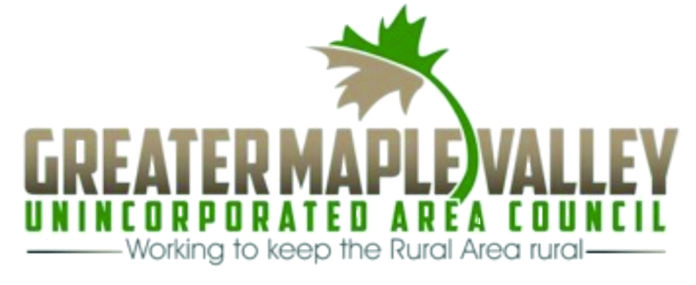The Area Council held its regular monthly meeting virtually on Monday, May 3. Major topics discussed were: (1) Countywide Planning Policies Update; (2) Cedar Hills Regional Landfill Community Meeting; and (3) School Siting Briefing Paper.
Our Guest Speakers were: (1) Nicole Sanders, Program Manager in the King County Department of Local Services Permitting Division and (2) Rory O’Rourke, Health and Environmental Investigator in the Environmental Health Services Division of Public Health – Seattle & King County.
The following is shown in order of the items addressed on the meeting Agenda.
Tahoma School District (TSD) Update
TSD Board member and Area Council committee member, Val Paganelli, provided an update. Tahoma We The People earned Top 10 status again in national competition. The Board continues its work on Five-Year Targets and Goals. Plans are being made for graduation for the class of 2021 at the high school campus. TSD’s learning recovery plan is due to the state by June 1. TSD is planning for full-time, in-person learning for K-12 in the fall.
The Asset Preservation Program annual review was completed and submitted to the State as required for capital assets that received state funding. Financial estimates include up to $6.9M in state and federal legislated funding for the 2020-2021 budget year for student, enrollment and transportation stabilization.
King County Green Building Program
Ms. Sanders discussed the Green Building Program. She shared a draft building code, but much of it does not apply to the Rural Area as it deals primarily with commercial properties and 4-story or more buildings. For more information on the County’s Green Building program please see: https://kingcounty.gov/depts/local-services/permits/permits-inspections/green-building.aspx.
Environmental Health
Mr. O’Rourke discussed environmental regulations, health concerns, and inspections at both the Cedar Hills Regional Landfill (CHRLF) and Cedar Grove Compost (CGC).
CHRLF — Its current 10-yr permit (2019-2029) includes long-term environmental issues such as gas releases, leachate ponds, etc. Seattle & King County Public Health validates compliance with the permit requirements. It receives many concerns from members of the Public. It conducts on-site inspections including odor control and the proper functioning of the aerators. These inspections typically are unscheduled visits. The Area Council asked questions about odors and gas releases; unmonitored areas by facility operators; location of leachate ponds within the 1,000-ft buffer; Volatile Organic Compound (VOC) releases; accountability; etc. For the most part, Mr. O’Rourke stated that their inspections cover all these issues and ascertain if both Federal and State requirements are being met. Mr. O’Rourke stated he has personally reviewed Public Comments on the CHRLF Comprehensive plan and other related plans, but that he did not review the Public comments to the Draft Environmental Impact Statement (DEIS) on the CHRLF Site Development Plan—the Area Council submitted ~90 pages of comments on the DEIS last Fall (see: http://gmvuac.org/wp/wp-content/uploads/2020/10/Comments-Draft-EIS-CHRLF-Site-Dvmt-Plan-Oct-20.pdf). The most recent report on CHRLF environmental monitoring can be reviewed here: https://your.kingcounty.gov/dnrp/library/solid-waste/facilities/CHRLF-annual-report-2019.pdf.
CGC — Annual permit issued for 2021. CGC generates ~250,000 lb per year of compost per year. Seattle & King County Public Health conducts on-site inspections including odor control. The Area Council asked questions about plastics content (measured by weight) of resulting compost product. CGC must meet State standards. It should be noted that measuring by plastic content by weight rather than by volume results in a lower standard, since plastics typically weigh less than compost.
The Puget Sound Clear Air Agency (PSCAA), a special-purpose government agency charted by State law, is a main regulatory agency that deals with both facilities.
Cedar Hills Regional Landfill (CHRLF) Community Meeting
On April 12, the King County Solid Waste Division (KCSWD) held a virtual Community Meeting in the form of a Zoom Webinar. Speakers from KCSWD included Pat McLaughlin, Scott Barden, Laura Belt, Mark Monteiro, Glynda Steiner, and Kevin Singer from BioEnergy Washington (BEW). Several Area Council Environment Committee members attended. A total of ~40 people attended, but were not visible to the general public. The following is a summary of what was stated by KCSEWD and what was discussed in response to the Public’s questions.
The BEW Facility is able to extract ~75% of the Methane from the landfill gas and convert it to pipeline-quality natural gas, producing enough energy to heat ~13,000 homes. They’ve upgraded their generators to make it more efficient in separating the components of the landfill gas.
The CHRLF is waiting for the Final Environmental Impact Statement (FEIS) for its Site Development Plan to determine future expansion. However, they appear to be definitely planning on building Area 9 in the last available land on the property, as there was no mention made of the further alternatives described in the Draft EIS (DEIS). Facilities will be temporarily moved to an offsite property in Renton for which KCSWD will have a 5-yr lease. Their current view is that the permanent facility will be located in the south buffer zone.
Other developments at the CHRLF include: (1) Final cover being placed on Area 7 this summer; (2) Evaluation of an “enviro cover” made of plastic as a daily cover that will eventually breakdown (concerns were raised about the microplastics eventually getting into the water through the leachate system; (3) Application of a construction permit to Puget Sound Clear Air Agency (PSCAA) to use an “intelligent odor control” substance to help reduce the odors from the leachate ponds (KCSWD claims it does not “mask” the odors, which is against regulations, but rather “neutralizes” them by breaking them down; and (4) Development of a cover system for the leachate ponds to control odors is in work.
Discussion of what protocols are in effect should a disaster prohibit access to CHRLF revealed there are none. Mr. McLaughlin assumed they would look to other landfills in the area and possible export to eastern landfills, but he was unsure of what they would do. This was very concerning.
The shallow east perched aquifer, which appears to be self-contained, is still under the Model Toxics Control Act (MTCA) status, because of contaminants and they are still working with Ecology and EPA to mitigate it. Testing of wells are done on a regular basis and water leaving the landfill has been determined to be clean, with no contamination.
The leachate pipe blockage and spill along Cedar Grove Rd did not contaminate the Cedar River. The cause was a piece of Geomembrane and a rock, but they don’t know how it got there.
Countywide Planning Policies (CPPs) Update
The CPPs serve as the guiding principles and policies for all Comprehensive Planning for King County and its Cities. The CPPs, which cover Environment, Development Patterns, Housing, Economy, Transportation, and Public Facilities & Services, currently are undergoing an update.
The Area Council has lead a joint team of seven Rural Area Unincorporated Area Councils/Associations (UACs/UAAs) to review draft policies developed by the King County Executive’s Office and an Interjurisdictional Team and to prepare and submit Comments. An initial set of joint comments were submitted to King County on January 11. On March 10 our joint team submitted a set of detailed comments on a draft Policy Matrix.
A Public Review Draft (PRD) was released on April 5. Our joint team review the PRD and prepared detailed comments. Our joint team’s organizations each individually discussed and voted to approve a final set of comments, as did the Area Council at tonight’s meeting following discussion. The joint team’s PRD Comments will be submitted by the May 5 due date.
To see all of the joint team’s submittals, as well as further information on the CPP Update, please see: http://gmvuac.org/countywide-planning-policies/.
The King County Growth Management Planning Council (GMPC) is expected to approve a final CPP Update by June 30. Each County city will go through its own approval process by September 30. The GMPC will submit its final CPP Update to the Puget Sound Regional Council (PSRC) by December 31.
PSRC School Siting Briefing Paper
TSD School Board member and Area Council committee member, Val Paganelli, provided a summary of the recently released Puget Sound Regional Council’s (PSRC’s) School Siting Briefing Paper.
VISION 2050 (https://www.psrc.org/vision), the four-county region’s plan for growth (King, Pierce, Snohomish & Kitsap), envisions that, by 2050, the region’s population will reach 5.8 million people, with an estimated increase of 160,000 in the age five to 19 cohort over that time. It acknowledges schools are community hubs and have wide-ranging competing priorities of cost, land use, transportation and public health & services demands. It also includes important updates to regional school siting policies and actions, along with policy language variances by county. It charges the PSRC with several actions to support school siting in the four-county region.
The briefing paper provides an overview of school siting challenges, legal context, and local issues as part of a broader long-term goal to improve the process by which cities, counties, and school districts plan for, collaborate, and coordinate future school needs.
Val has provided the briefing paper to the TSD Superintendent, fellow Board members and leaders of the student housing committee leaders. The Area Council requested Val arrange for the TSD Superintendent to come to a future meeting to discuss school siting.
Members of the Area Council participated in King County’s 2011/2012 School Siting Task Force (https://kingcounty.gov/elected/executive/constantine/initiatives/school-siting-task-force.aspx), which is discussed and referenced in the briefing paper.
Upcoming Area Council Meetings
The next Area Council monthly meeting will be held Monday, June 7 — another “virtual” meeting via Zoom—access information will be posted on the Area Council’s website www.gmvuac.org.
All regular monthly meetings are held on the first Monday of the month, from 7 – 9:30 PM. Meeting announcements are published in the VOICE of the Valley, the Area Council’s website (www.gmvuac.org) and local NextDoor platforms. You can also find us on Facebook. Each meeting begins with an open Public Comment period. [When State restrictions are lifted, the Area Council will again meet face-to-face with members of the Public invited to attend. Meetings will be held at the Maple Valley Fire Station—SE corner of SE 231st St & SR-169 intersection across from the Police Precinct.]
Area Council Membership
Your Area Council serves as an all-volunteer, locally recognized advisory body to King County on behalf of all rural unincorporated area residents living in the Tahoma School District. The Area Council’s Vision Statement is:
“Our community’s Rural Character will be supported by facilitating strong local ties and communication between the public, organizations, and government; promoting locally owned businesses and supporting quality education; protecting the environment, and maintaining landowners’ rights and responsibilities; promoting controlled and well-planned growth with appropriate infrastructure; ensuring proper representation for rural interests and needs; and supporting the health and safety and the privacy of our vibrant community.”
The twelve-seat Area Council currently has three open seats. If you have an interest in joining please send an e-mail to: info@gmvuac.org or attend a monthly meeting and express your interest.
Citizens who are not members of the Area Council or do not live within the Tahoma School District still are eligible to join and serve on any of the Area Council’s three major subject-matter Committees: Environment, Growth Management, or Transportation, as well as the Ad Hoc Economic, Public Relations, and Train Show Committees. The Area Council welcomes your participation. For information on each of these committees please see the Area Council’s web site: www.gmvuac.org and use the drop-down menu under Committees. Thank you.









